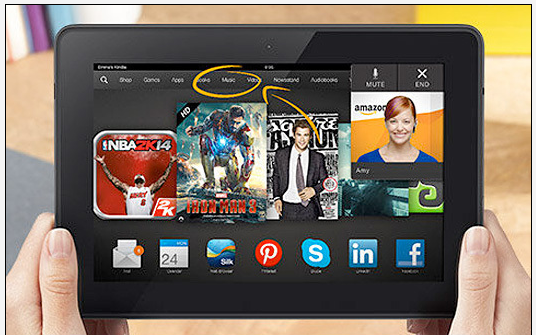 Amazon makes constant, incremental improvements in ecommerce, self-service and assisted service every time it introduces a new device, and related services. The company can already take credit for “one-click check-out” to overcome abandoned shopping carts and recommendation engines to take advantage of “the wisdom of crowds.” When the new line of Kindle Fire tablets become generally available later this year, its “Mayday Button,” (a play on the French imperative “m’aidez,” meaning “help me”) it will herald “one-click technical support,” a dramatically better way to shorten the time it takes to receive meaningful, real-time assistance from Amazon’s cadre of customer care technicians.
Amazon makes constant, incremental improvements in ecommerce, self-service and assisted service every time it introduces a new device, and related services. The company can already take credit for “one-click check-out” to overcome abandoned shopping carts and recommendation engines to take advantage of “the wisdom of crowds.” When the new line of Kindle Fire tablets become generally available later this year, its “Mayday Button,” (a play on the French imperative “m’aidez,” meaning “help me”) it will herald “one-click technical support,” a dramatically better way to shorten the time it takes to receive meaningful, real-time assistance from Amazon’s cadre of customer care technicians.
The Mayday button is a radical change in the customer care paradigm. It signals that Amazon’s product team acknowledges that, no matter how simple or intuitive you make a new device, new owners are bound to hit snags as they discover new capabilities or initiate new services. The notion of having a knowledgeable product expert with technical chops just a click away is powerful. The button looks like a life preserver and is located among the “settings” (where owners input Wi-Fi and Bluetooth options). When the button is pushed, a dialogue box opens that includes a live video image of your support representative. By default, you can see your assistant, but they can’t see you. Instead, they can hear what the device owner says, make drawings on the device’s screen (to point to various controls) and check device status remotely.
Amazon founder Jeff Bezos sees Mayday as a service that lives at the intersection of “Customer Delight” and “Deep Integration with the entire stack.” The first term is already something of a cliche, but we get the idea. The second term lapses into geekiness, but indicates that Amazon, by virtue of its longevity in ecommerce and huge presence in cloud computing and web services, is ready to revolutionize how individuals take control of their mobile devices and the services that are offered through them. Nobody has used the magic word “WebRTC” when talking about Mayday, and that surprises me because the support button embodies WebRTC’s prime directive: embedding real-time voice, text and video communications capabilities within Web browsers.
Though screen sharing and drawing lines on remote computers aren’t explicitly included in the WebRTC spec (not to mention that , I’ve seen enough demonstrations of open collaboration tools to know that the Mayday button takes us one step closer to purpose-driven, impromptu initiation of clientless voice and video-based real-time communications (analogous to, if not precisely a WebRTC-enabled service). The fact that it is an out-of-the-box feature/function of an Amazon-branded tablet is ingenious and should embolden competing providers of wireless devices to integrate the same sorts of capabilities into the customer care and technical support fabrics. That means that we have only begun to see what “deep integration with the entire stack” means.
Can a speech-enabled, automated personal virtual assistant be far behind? Amazon has been a very active acquirer of high-quality automated speech processing technology providers, including speech recognition/transcription specialist Yap and human-like text-to-speech rendering expert IVONA. More recently it added personal virtual assistant creator EVI (formerly known as True Knowledge). So I think it can accurately be argued that we have not yet begun to see the “deep integration” of a complete Amazon stack that already includes speech processing, natural language processing, machine learning, capacious cloud-based storage and levels of compute power that only a few industry giants – primarily Google, Microsoft, IBM, AT&T and Apple – can rival. So, if pressing a Mayday button proves too onerous for some, carrying out a conversation with an automated support system may do the trick.
As noted above, Amazon’s leadership in the ecommerce domain has been based on constant, incremental improvements. Mayday solves a big problem for the targeted demographic of non-computer savvy individuals who are upgrading from e-readers to full-blown tablets. It brings tech support straight to the glass. And it will start conditioning owners to be comfortable talking to their devices. The next challenge, I predict, will be to fulfill on the promise of a sub-15 second response time. If we’ve learned anything from the past, it is that automated self-service has a role to play when reducing hold times is an objective. The good news is that, rather than listening to music on hold (punctuated with occasional messages to notify them of the time it will take to talk to an agent), they could easily be enticed into interacting with a speech-enabled chatbot – ready, willing and able to navigate them through the rough patches of device set up, service initiation and more.
For perspectives from my colleague Greg Sterling, visit his post on Internet2Go.net.
Categories: Articles

 2025 Conversational AI Intelliview: Decision-Makers Guide to Self-Service & Enterprise Intelligent Assistants
2025 Conversational AI Intelliview: Decision-Makers Guide to Self-Service & Enterprise Intelligent Assistants  Why Is ElevenLabs Building a Conversational AI Stack?
Why Is ElevenLabs Building a Conversational AI Stack?  Talk to the Web: How NLWeb Opens Conversational Access to Site Content
Talk to the Web: How NLWeb Opens Conversational Access to Site Content  Battling ‘Botenfreude’: The Power of People and Policy
Battling ‘Botenfreude’: The Power of People and Policy